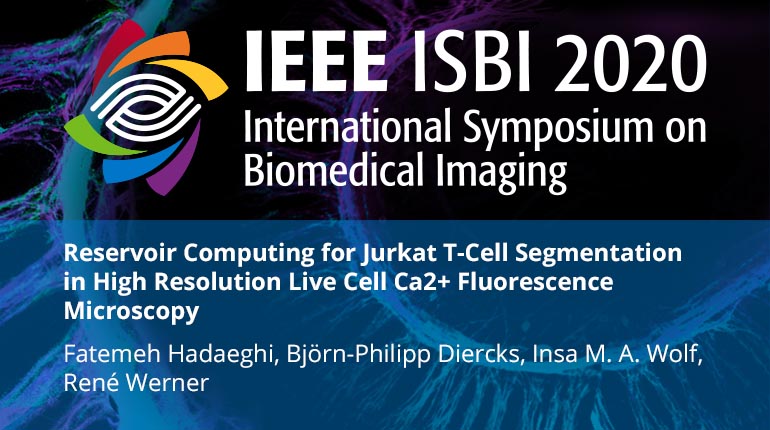
Already purchased this program?
Login to View
This video program is a part of the Premium package:
Reservoir Computing for Jurkat T-Cell Segmentation in High Resolution Live Cell Ca2+ Fluorescence Microscopy
- IEEE MemberUS $11.00
- Society MemberUS $0.00
- IEEE Student MemberUS $11.00
- Non-IEEE MemberUS $15.00
Reservoir Computing for Jurkat T-Cell Segmentation in High Resolution Live Cell Ca2+ Fluorescence Microscopy
The reservoir computing (RC) paradigm is exploited to detect Jurkat T cells and antibody-coated beads in fluorescence microscopy data. Recent progress in imaging of subcellular calcium (Ca2+) signaling offers a high spatial and temporal resolution to characterize early signaling events in T cells. However, data acquisition with dual-wavelength Ca2+ indicators, the photo-bleaching at high acquisition rate, low signal-to-noise ratio, and temporal fluctuations of image intensity entail corporation of post-processing techniques into Ca2+ imaging systems. Besides, although continuous recording enables real-time Ca2+ signal tracking in T cells, reliable automated algorithms must be developed to characterize the cells, and to extract the relevant information for conducting further statistical analyses. Here, we present a robust two-channel segmentation algorithm to detect Jurkat T lymphocytes as well as antibody-coated beads that are utilized to mimic cell-cell interaction and to activate the T cells in microscopy data. Our algorithm uses the reservoir computing framework to learn and recognize the cells -- taking the spatiotemporal correlations between pixels into account. A comparison of segmentation accuracy on testing data between our proposed method and the deep learning U-Net model confirms that the developed model provides accurate and computationally cheap solution to the cell segmentation problem.
The reservoir computing (RC) paradigm is exploited to detect Jurkat T cells and antibody-coated beads in fluorescence microscopy data. Recent progress in imaging of subcellular calcium (Ca2+) signaling offers a high spatial and temporal resolution to characterize early signaling events in T cells. However, data acquisition with dual-wavelength Ca2+ indicators, the photo-bleaching at high acquisition rate, low signal-to-noise ratio, and temporal fluctuations of image intensity entail corporation of post-processing techniques into Ca2+ imaging systems. Besides, although continuous recording enables real-time Ca2+ signal tracking in T cells, reliable automated algorithms must be developed to characterize the cells, and to extract the relevant information for conducting further statistical analyses. Here, we present a robust two-channel segmentation algorithm to detect Jurkat T lymphocytes as well as antibody-coated beads that are utilized to mimic cell-cell interaction and to activate the T cells in microscopy data. Our algorithm uses the reservoir computing framework to learn and recognize the cells -- taking the spatiotemporal correlations between pixels into account. A comparison of segmentation accuracy on testing data between our proposed method and the deep learning U-Net model confirms that the developed model provides accurate and computationally cheap solution to the cell segmentation problem.
 Cart
Cart Create Account
Create Account Sign In
Sign In





